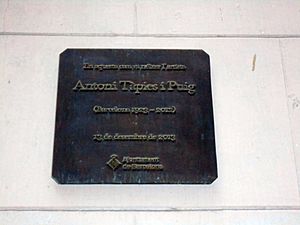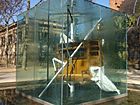Antoni Tàpies facts for kids
Quick facts for kids
The Most Illustrious
Antoni Tàpies
|
|
|---|---|

Tàpies in 2008
|
|
| Born | 13 December 1923 Barcelona, Spain
|
| Died | 6 February 2012 (aged 88) Barcelona, Spain
|
| Nationality | Spanish |
| Known for | Painting, sculpture, lithography |
| Movement | Art informel |
| Awards | Praemium Imperiale |
Antoni Tàpies i Puig, who later became the 1st Marquess of Tàpies, was a famous Spanish painter, sculptor, and art thinker. He was born on December 13, 1923, and passed away on February 6, 2012. Tàpies became one of the most well-known European artists of his time.
Contents
Life of Antoni Tàpies
Antoni Tàpies Puig was born in Barcelona, Spain, on December 13, 1923. His father was a lawyer and a Catalan nationalist. This meant his father supported the idea of Catalonia being a separate nation. Tàpies grew up around important people in Catalan public life. His grandmother also played a big role in civil and political activities.
In 1934, when Tàpies was 10, he first saw modern art. He saw a special magazine issue with pictures of art by famous artists like Duchamp and Picasso. At 17, Tàpies had a serious heart attack because of tuberculosis. He spent two years recovering in the mountains. During this time, he read a lot and developed his interest in art.
Tàpies studied at the German School of Barcelona. He studied law for three years, but by 1943, he decided to focus only on painting. In 1945, Tàpies started trying new materials. He mixed oil paint with chalk. He also became very interested in philosophy, especially Eastern ideas.
Tàpies became one of Spain's most famous artists in the second half of the 20th century. His unique and modern artworks were shown in museums worldwide. In 1954, Tàpies married Teresa Barba Fabregas. They had three children: Antoni, Miguel, and Clara. Tàpies lived mostly in Barcelona and passed away on February 6, 2012. He had been unwell since 2007.
Antoni Tàpies' Art Work
Antoni Tàpies was perhaps the most famous Spanish artist after the Second World War. He first learned about modern art from a magazine when he was a teenager. During the Spanish Civil War (1936–39), he taught himself to draw and paint. In the early 1950s, he lived in Paris for a while on a scholarship. A very important French art critic, Michel Tapié, helped make Tàpies's work famous.
In 1948, Tàpies helped start the first art group in Spain after the war. It was called Dau al Set. This group was linked to Surrealism and Dadaism, which were art movements that explored dreams and nonsense. The main leader of Dau al Set was the poet Joan Brossa.
Tàpies started as a surrealist painter, influenced by artists like Paul Klee. But soon, he became an informal artist. He worked in a style called pintura matèrica, which means "matter painting." In this style, artists add unusual materials to their paintings. In 1953, he began mixing different materials. This is seen as his most original contribution to art. He was one of the first to create serious art this way. He added clay and marble dust to his paint. He also used things like waste paper, string, and old rags. An example is his Grey and Green Painting from 1957. His work Canvas Burned to Matter (around 1960) combines ideas from Dada and Surrealism.
By the end of the 1950s, Tàpies was well-known around the world. From the late 1950s to early 1960s, Tàpies worked with other Spanish artists like Enrique Tábara. In 1966, he faced challenges for being involved in political activities against the government. His art in the early 1970s often showed symbols of Catalan identity. This was something the government at the time, led by Francisco Franco, did not like. In 1974, he made a series of prints called Assassins. These were shown in Paris to honor people who disagreed with the government.
Around 1970, Tàpies was influenced by Pop art. He started adding bigger objects to his paintings, like parts of furniture. Tàpies's ideas have influenced art worldwide, especially in painting, sculpture, and printmaking. His works are in many major art collections. His art is connected to styles like Tachisme and Abstract Expressionism.
Later in the 1970s and 1980s, Tàpies's paintings showed a calm, empty feeling. He used spray paint with lines that looked like Asian writing. He continued to use mixed materials. He also hinted at images within his abstract art, like in Imprint of a Basket on Cloth (1980).
Graphic Art Works
From 1947, Tàpies also created many graphic works. These included special books and art collections. He worked with poets and writers from around the world to create these pieces.
Essays and Writings
Tàpies wrote several essays about art, life, and politics. These writings were collected in books. In his essays, he thought about the role of art and artists in society. He also explained what influenced his work and shared his artistic and political ideas.
Art Movements and Styles
Antoni Tàpies was part of several important art movements during his life. He was associated with Art Informel and a style called Haute Pâte or Matter Painting. In 1948, he joined the avant-garde group Dau al Set. This group had strong connections to Surrealism.
His early works were surrealistic, but by 1953, he began working in abstract art. This is when he became part of the Art Informel movement. Art Informel in Europe was similar to Abstract Expressionism in America. It was one of the most popular art styles after World War II.
Within Art Informel, there is a category called Matter Painting. This style focuses on using unusual objects. It goes against traditional fine art. Some of Tàpies's most famous and original works are in this style. They are known for his use of marble dust and clay mixed with paints. He also added everyday items like string, paper, and cloth. In the late 1960s and early 1970s, Tàpies was influenced by Pop Art. Because of this, he started using larger items, such as pieces of furniture, in his artworks.
Exhibitions of His Art
- In 1950, Tàpies had his first solo art show in Barcelona. His work was also shown in a big international exhibition in Pittsburgh.
- In 1953, he had his first shows in the United States, in Chicago and New York.
- In 1962, he had a special show called a Guggenheim Retrospective. This type of show looks back at an artist's entire career.
- Other big shows of his work were held in Paris in 1973 and in Buffalo, New York, in 1977.
- Later, his art was shown in Paris in 1994 and in Hannover, Germany, in 1998.
- In 2000, he had an exhibition in New York that included paintings, small sculptures, and mixed-media works.
- His art was also shown at the Museo Nacional Centro de Arte Reina Sofía in Madrid in 2000. He had exhibitions at the Anita Shapolsky Gallery in New York City in 2006, 2012, and 2014.
- In 2007, at 83 years old, Tàpies had an exhibition where he showed 17 paintings on wood and canvas.
- In 2017, an exhibition called Tàpies: Paintings, 1970–2003 was held in New York.
Legacy of Antoni Tàpies
The Fundació Antoni Tàpies is a museum and cultural center in Barcelona, Spain. It is dedicated to the life and works of Antoni Tàpies. Tàpies himself started it in 1984. He wanted to create a place to learn about modern and contemporary art.
The foundation holds temporary exhibitions, film screenings, lectures, and other activities. It also shows many of Tàpies's own artworks, most of which he donated. The foundation has a large library focused on artists of our century and modern art history.
Awards and Recognition
- In 1958, Tàpies won the First Prize for painting at the Pittsburgh International. He also received the UNESCO and David E. Bright Prizes at the Venice Biennale, a very important art exhibition.
- In 1958, Tàpies and Eduardo Chillida represented Spain at the Venice Biennale.
- He received the Rubens Prize in Germany in 1972.
- In 1994, he received an Honorary Doctorate from the Rovira i Virgili University. This is a special award from a university.
- In 2003, Tàpies won Spain's highest art award, the Velázquez prize.
- On April 9, 2010, King Juan Carlos I gave him the special title of Marqués de Tàpies (Marquess of Tàpies). This is a noble title.
- He also designed the logo for Rovira i Virgili University. It features the letter "a," which represents the idea of universal knowledge.
Gallery of works
See also
 In Spanish: Antoni Tàpies para niños
In Spanish: Antoni Tàpies para niños













